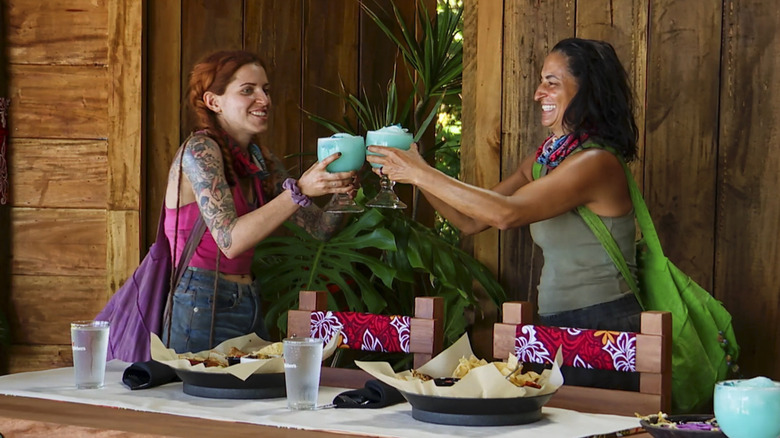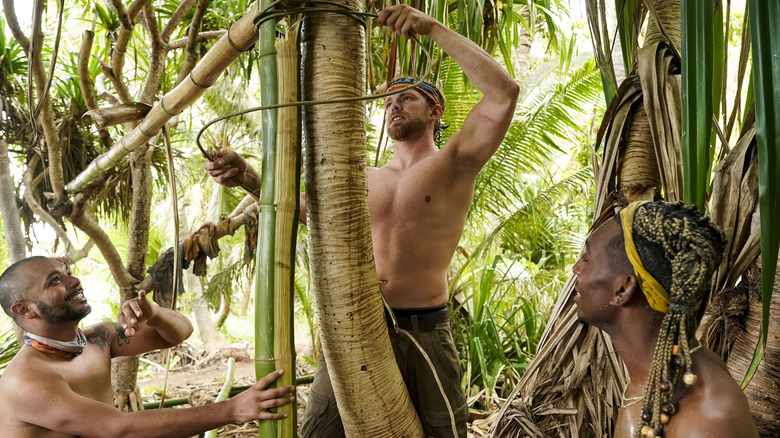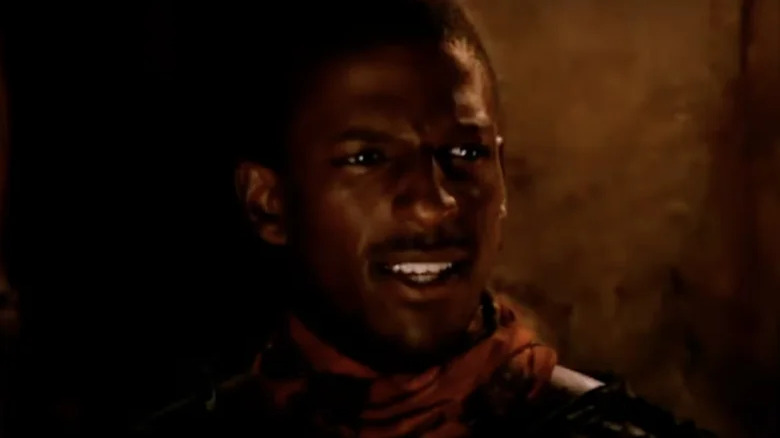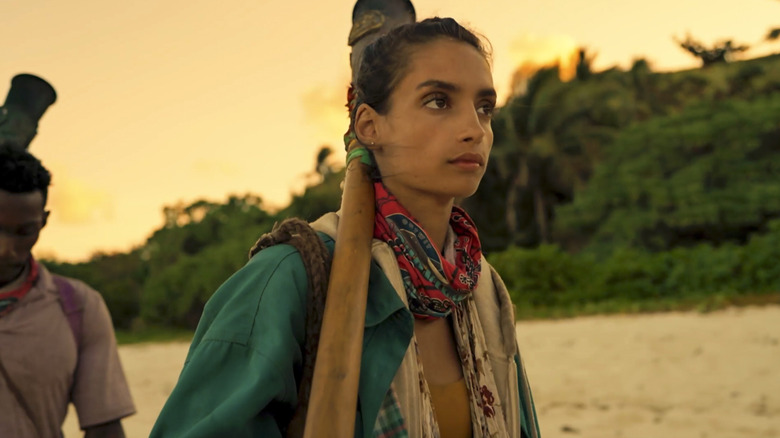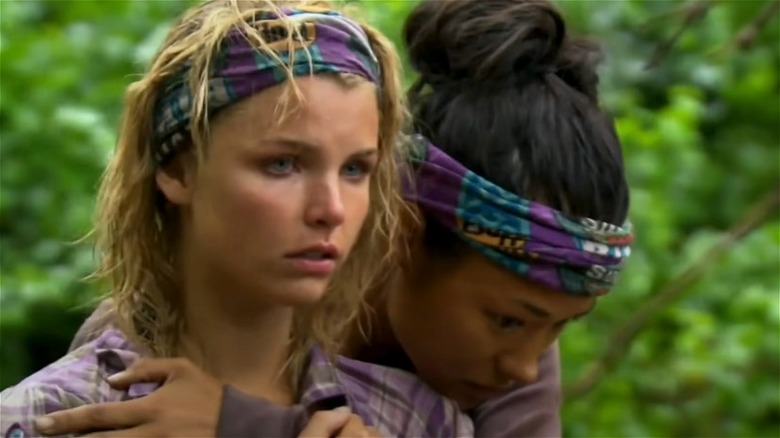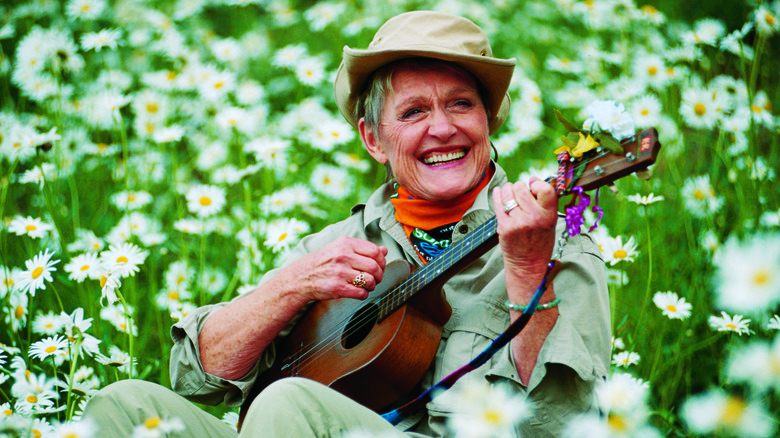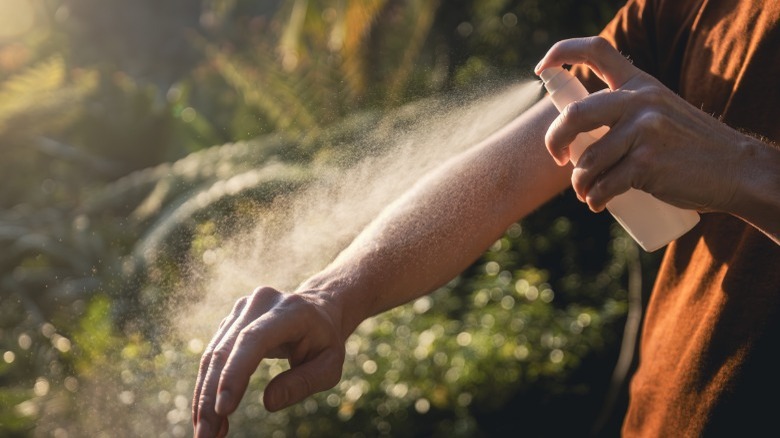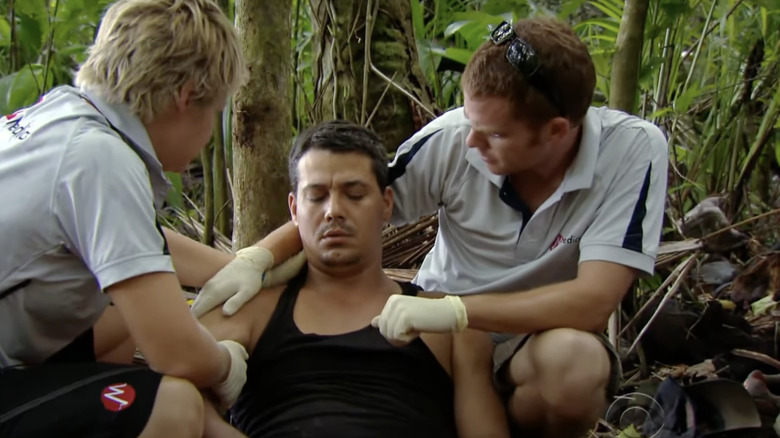Things You Didn't Realize Survivor Contestants Have Access To
We may receive a commission on purchases made from links.
In case you've never seen the show, the whole point of "Survivor" is that its contestants don't have access to much. Each tribe may receive a canteen or old pot, but beyond that, they're largely left to fend for themselves. Or are they? This is reality TV, after all. It's no great secret that reality programs are usually more scripted than they lead viewers to believe. As the seasons piled on and viewers noticed things like a lack of body hair growth, glowing white teeth in the outback, and endless amounts of drinking water without contestants having to boil it, it's only fair to wonder what exactly they're not showing.
The truth is, "Survivor" has either done an amazing job maintaining the competitive integrity of the show or excelling at paying off previous cast members for silence. 48 seasons (and counting!) of contestants confirm that the closest thing they ever got to a toothbrush was a stick of bamboo dipped in ash. There are certainly no air mattresses and gas-powered camping stoves tucked away for lounging between takes.
Still, don't contestants need certain things that never make it on camera? A few surprising items are accessible for players, hidden from camera 2's sight. Here are the off-camera assets "Survivor" players rely on to make it home in one piece.
Survivor contestants are provided with medical supplies and condoms
While "Survivor" seeks to push its players to their limits and simulate real survival situations, the crew also wants all players to survive filming. To help them do that, the show provides players with an off-camera storage container packed full of survival equipment. The box contains essentials like contact lens solution, sunscreen, and medications. There are strict rules around using this medical equipment, mainly to protect the legitimacy of the show. Because producers don't want to film competitors using things not native to the location, only one person can access the box at a time, and contestants are not allowed to speak to each other while applying sunscreen.
Previous contestant Janet Koth was quite amused that the show gave an all-women tribe plenty of condoms, but her team still found ways to use them. Fellow tribe member Christy Smith used the condoms to protect her blistered feet while on jaguar watch. Somehow, that magnificent footage didn't make it to air, but you have to wonder what would have happened if Christy had actually bumped into a jaguar while wearing two lubricated socks.
Contestants receive survival training
No, "Survivor" producers are not only picking participants who already know how to start a fire with flint and wrap palm fronds into shelters. The reason both tribes are usually capable of doing the bare minimum to survive in the harsh conditions is because players receive four days of intense wilderness training."Survivor" producers told People that these sessions provide a crash course in survival and "general overall jungle safety."
This session is called Survival School, and it typically features essential life-saving tips that are relevant to the season's location. Behind-the-scenes Instagram shots from Entertainment Weekly's Editorial Director Dalton Ross show Survival School before "Survivor: Cook Islands." Contestants were taught by island natives how to weave palm fronds and build shelters. They even taught the cast which local flora, fauna, and animals were edible. "Survivor: The Amazon" contestant Daniel Lue felt like the competition actually started during these training sessions, as he explained to Entertainment Weekly. Although contestants weren't allowed to speak to each other during the training, everyone was sizing up the competition through non-verbal cues and forming alliances that would eventually influence the show.
They get clean drinking water on Survivor now
Early seasons of "Survivor" required the tribes to find their own potable water. Before they could start a fire and properly purify water, contestants had to choose between dehydration or drinking water from murky sources, which led to a whole host of complications. A previous contestant, Eliza Orlins, told The Ringer that she contracted a parasite called giardia in Vanuatu. Season 3 featured footage of tribes taking drinking water and doing laundry from an elephant's toilet, resulting in several players getting sick from the drinking water. We even saw Oston Taylor quit the show in Season 7 after succumbing to extreme dehydration.
At some point, the production team must have quietly conceded that providing contestants with potable water makes for a better show. At the very least, it surely saved them thousands of dollars in medical expenses. An unnamed cameraman revealed in a Reddit AMA that for the last 13 years, each tribe has had access to a well of drinkable water that gets replenished as needed. Imagine being the person who joined the show and had to drink from an elephant's bathroom, only to find out later that contestants got to enjoy the tropical fruits of Fiji with an unlimited supply of drinkable water.
That doesn't mean it's all sunshine and fresh mountain spring water. Legendary competitor Tyson Apostol explained to Insider that the sitting water gets dirtier as the contest wears on. By day 39, he never wanted "to drink water again."
There are rides to Tribal Council
While most seasons of "Survivor" feature B-rolls of tribe members gathering up their belongings, waving flags, and marching along deserted shorelines to Tribal Council, the reality is a bit less "Castaway" and a bit more "24." According to Today journalist Andy Dehnart, who spent a week on the set of "Survivor: Gabon," contestants are whisked towards Council and challenges in vehicles with covered windows, so players cannot see where they are going. During this transport, no one is allowed to speak to each other, as the production crew doesn't want any juicy soundbites leaking out while the cameras aren't rolling. Footage of a backstabbing in the backseat of a minivan just wouldn't fit in with the rest of the show.
To maintain the impression, contestants are told to line up and march down the beach as if they are setting off for the Tribal Council, but they are actually just walking back and forth in circles. Sometimes, players are taken to Council in boats rather than overland vehicles, but they have not walked to their destinations since the show's early seasons. This change ensures no strategy talk is missed by the camera crews during the walk, but it also robs us of beautiful footage of players trying to navigate ants, snakes, and rough jungle pathways with a voiceover of Jeff lecturing the players on being all talk and no action.
Psychologists are there for the Survivor contestants
We've seen the medical staff make appearances on "Survivor," typically during the show's most frightening moments. First responders helped Kourtney Moon when she fractured her wrist, rescued Michael Skupin when he fell into a fire, and breathed life back into Russell Swan when he fainted during an immunity challenge. While all contestants' physical wounds healed eventually, mental scars can be more difficult to recover from.
What we don't see on screen are the mental health professionals who help the contestants who aren't taken away in medical evac helicopters. Jeff Probst himself said on his "On Fire" podcast that "Survivor" has a mental health staff alongside their medical team who are ready to step in at any sign of real trouble. These psychologists have plenty of work on their hands, traveling with the game and maintaining communication with players following their appearance on the show.
Past contestant Matt Bischoff said in an interview with Entertainment Weekly, "Pretty much every 'Survivor' [player] I have ever met talks about the woulda coulda shoulda scenarios that will haunt you forever." Former participants have shared that they receive wellness calls from "Survivor" psychologists to help them work through the transition back to normal life, as well as walk them through things like the inevitable self-esteem issues that come with such high-profile failures.
Survivor contestants must bring their own menstrual products
Despite other medical supplies being provided by the production team of "Survivor," contestants who require menstrual products must bring their own from home. According to past contestants, you have the opportunity to submit a medical bag before the show begins filming. Part of this bag can include period products, like tampons, and other related items, like birth control.
These items are stored in the same box as the rest of the medical supplies at camp. Presumably, the rules of using items like tampons and pads are similar to sunscreen and other items in the box. Only one person could go to the box and use items at a time. On TikTok, former contestant Kelley Wentworth shared that used tampons would then be disposed of in baggies in a dedicated trash can in the box.
Another contestant, Lauren O'Connell, has spoken about her experience having her period on the show. She detailed on TikTok how she had a 30-day-long menstrual cycle due to stress. Thankfully, she had a medical bag with plenty of supplies from home. O'Connell noted that "Survivor" production requires contestants to submit a 3-month supply of medical necessities. This ensures that if contestants are moved around to a different camp, production can quickly get them their menstrual products. However, Lauren-Ashley Beck had a mishap with her own supply of tampons during her season. For an interview with Business Insider, she explained how she got her period twice while filming, which led to her running out. A crew member had to purchase more from nearby.
Survivor contestants receive help from expert snake handlers
It's all fun and games, until a very real, very venomous snake appears in the camp. According to "Survivor" contestant Benjamin "Coach" Wade, snakes would crawl across the roof of their shelter. To avoid the potential of someone receiving a deadly bite, he indicated to Self magazine that production had a snake handler ready to go to remove snakes from "Survivor" camps.
According to former players, instead of letting contestants come face-to-face with nature's most dangerous wild animals and learn how to survive when they attack, they call in the professionals. However, this is not confirmed by CBS and remains up for debate on online forums. Past "Survivor" seasons have seen contestants experience close encounters with snakes, such as Richard Hatch in the very first season, who threw a snake into the ocean. So, it seems likely that "Survivor" would provide professional expertise and tools if any player ever encountered a creature that could cause serious harm.
Survivor contestants are allowed items with an emotional connection
While the show is called "Survivor" and your mind first goes to the tools and supplies a person needs to survive in the wild, contestants are also allowed items linked to emotional well-being. These so-called "luxury" items were a big part of early seasons. Players would vie for the chance to have access to something from home that had some important emotional connection for them.
However, Jeff Probst indicates that they still request these items from contestants – things like photos from home, a special piece of jewelry, etc. They just haven't appeared as prominently in the gameplay like before. Viewers should remember that although they're styled as "luxury" items, these are personal mementos. For example, contestant Sonja Christopher, as shown above, brought her beloved ukulele for the show's very first season. Tools and items that can be linked at all to survival skills or needs are prohibited — which means you'll have to leave your favorite camping knife at home.
Survivor provides insect repellent, but is it effective?
Considering some of the gnarly locations where "Survivor" has been filmed, bug repellent should be a necessity. If you believe that contestants should have access to it, then you'll be happy to know that production agrees with you. However, the utility of the bug repellent is debatable. Instead of a bug spray in an aerosol can, players are provided with a combination sunscreen and bug repellent in their medical box located a little bit away from camp.
This combination of sunscreen and bug repellent might have been in use since the early days of the show. Executive producer Mark Burnett explained to CBS in 2003 that contestants are given a local insect repellent. In fact, it wasn't even a repellent. "It's a coconut oil that you put on and it drowns the bugs, because we don't want them getting bitten to death," he shared.
On an online forum, discussions about this insect repellent lead one to believe there is much to be desired. Despite using the product, players from many seasons, including those filmed on the Marquesas, experienced terrible bug bites. Jeff Probst says this was the absolute worst location Survivor has ever filmed, in large part due to the bugs. On Instagram, Shirin Oskooi showed off the many bug bites she received filming in the Marquesas.
Access to emergency medical services 24/7 on Survivor
While the point of the show is to mimic conditions where a group of people would need to survive with limited resources in the jungle, there are limits. Safety always comes first on "Survivor". After 48 seasons, only 19 players have ever been emergency evacuated out of this reality show for medical concerns, as of this writing. But countless others have stayed in the game after being treated by a team of medical professionals dedicated to their care. "Survivor" employs a full team of doctors and nurses who are ready to go any time during the filming of each season.
For an interview with Entertainment Weekly, host and executive producer of the show, Jeff Probst, offered insights into the reality of this on-call medical team. During a challenge on "Survivor: Kaôh Rōng," three contestants passed out from heat exhaustion. One contestant, Caleb Reynolds, required immediate evacuation to a hospital. Probst pointed out the fast-acting abilities of their production team and medical staff meant "that Caleb was in the air on a chopper with a doctor at his side within twenty-two minutes of collapsing." So, for minor ailments and issues, contestants might push themselves, but "Survivor" ensures access to the best medical care in case of dire emergencies.
"Survivor" can be purchased on Prime Video.
